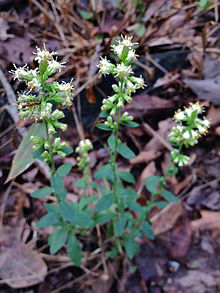Solidago bicolor
| Solidago bicolor | |
|---|---|

| |
| Scientific classification | |
| Kingdom: | Plantae |
| Clade: | Tracheophytes |
| Clade: | Angiosperms |
| Clade: | Eudicots |
| Clade: | Asterids |
| Order: | Asterales |
| Family: | Asteraceae |
| Genus: | Solidago |
| Species: | S. bicolor
|
| Binomial name | |
| Solidago bicolor L.
| |
| Synonyms[1][2] | |
|
Synonymy
| |
Solidago bicolor, with several common names including white goldenrod[1][3] and silverrod,[1] is a plant species native to much of eastern North America.[4][1] It is found in Canada (from Manitoba to Nova Scotia) and in the United States (every state completely east of the Mississippi except Florida).[5] It prefers sandy and rocky soils, and can frequently be found along roadsides.

Solidago bicolor is distinctive in the genus. Stems are thin and wiry. Flowers are white rather than yellow, the heads mostly clustered in the axils of the leaves rather than displayed in a large terminal raceme.[1]
Galls[edit]
This species is host to the following insect-induced gall:
- Rhopalomyia guttata Dorchin
References[edit]
- ^ a b c d e Flora of North America, Solidago bicolor 1767, White goldenrod , silverrod , verge d’or bicolore
- ^ The Plant List, Solidago bicolor
- ^ USDA, NRCS (n.d.). "Solidago bicolor". The PLANTS Database (plants.usda.gov). Greensboro, North Carolina: National Plant Data Team. Retrieved 18 November 2015.
- ^ Linnaeus, C. Systema Naturae, ed. 12 2: 556. 1767.
- ^ Biota of North America Program 2014 county distribution map

